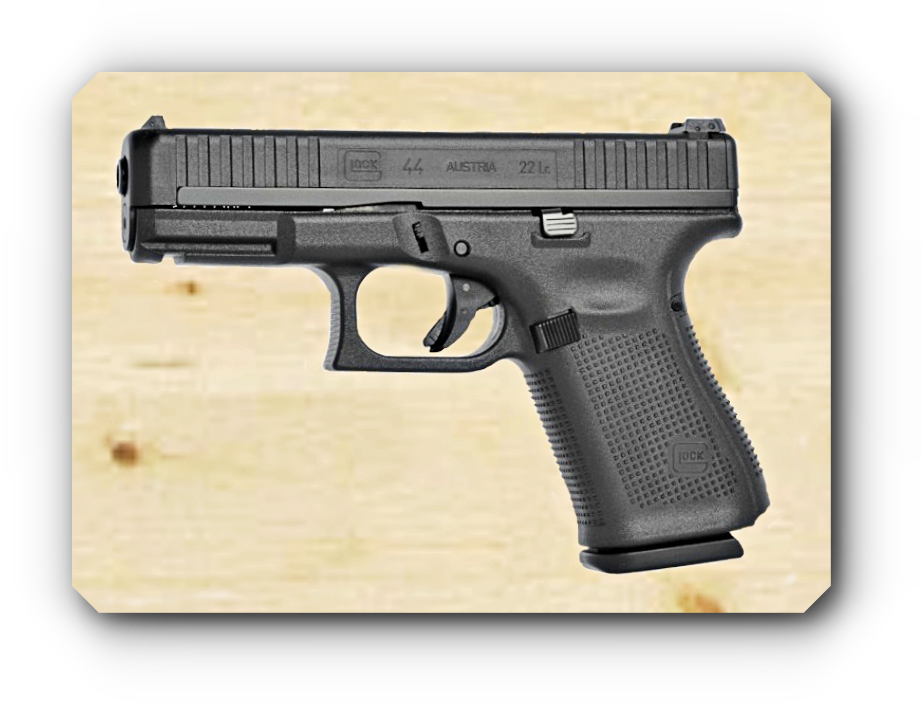
In 2019, Glock announced a new pistol, the G44. It was not due out to the public until January 2020. I went to Midway USA to see if they were scheduled to receive the Glock G44 and, sure enough, it was on the list. I clicked the option to notify me when the product came in, and sure to form, I was. It was cut bait of fish time for me, and I decided to fish and placed an order.
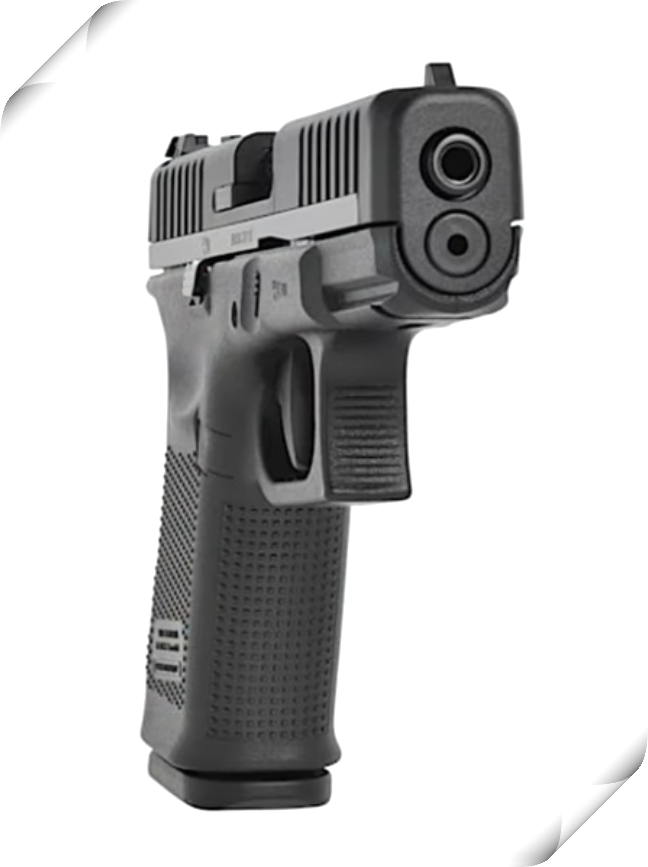
I had read some review articles and viewed a few videos on the G44 by those who are fortunate enough to receive one for test and evaluation purposes. All the reviews were favorable with one caveat, the ten round capacity. I’ll get into capacity later. For now, I will just tackle reviewing the G44.

The operating system is a simple blow-back mechanism similar to the G25 and G28 .380 Auto pistols, the power of the .22 LR is by far less than the centerfire calibers chambered by Glock, and a blow-back system makes sense and all other .22 LR rimfire pistols on the market use a blow-back system.
Technical data and dimensions are shown below.


The first thing that can be said regarding the G44 is that the dimensions are identical to a Glock G19. Those who have a Glock G19 will become immediately familiar with the pistol the first time they pick one up. What they will not be familiar with is the weight. From the Technical Data, the loaded weight of the G44 is only 16.4 ounces! That is only a pound of pistol!
One of the major differences between the G44 and other Glock pistols, aside from weight, is the slide that is polymer with a reinforced steel rail. Front and rear serrations are provided as is standard Glock sights.
If you had only the frame of the G44 in your hand, you would swear that you are holding a G19. Everything about the frame, including the trigger, is the same as that found on the G19. But, I want to focus a bit on that slide. Is this simply a .22 conversion kit that can be purchased online for about $295? Some would say that they have a complete pistol with the G44 rather than having to replace the slide each time that they wanted to shoot .22 ammunition and are willing to pay the extra $135 (based on MSRP, although the G44 can be found for less) for such a pistol. There is some credence to that for some, I suppose. One thing to consider is that .22 conversion kits are just that, kits that convert from one caliber to the .22 cartridge. The G44 is a complete, integrated package that is designed specifically for the .22 cartridge.
I already have a few .22 caliber pistols; such as the Ruger MKIV and Smith & Wesson Victory, along with a few others. So, what compelled me to purchase the G44? One reason was curiosity. I really wanted to see how Glock was going to pull this off, although I would have been more excited over, say, a Glock 9mm carbine. Another reason was that I simply wanted to experience a new product rather than wait for a year until it was fully fielded and tested by others. A third reason is that I wanted something to take to the range for practice; something that I was familiar with and could also compare to my other .22 pistols. Cheap practice with less expensive ammunition is always a plus – if you do it in moderation. I say moderation because one could get hooked on shooting with a lot less recoil and tend to forget to practice with something a lot more powerful that one carries for personal defense. The final reason is that I have shot a few Glock pistols and the familiarity, sans weight, would be very familiar to me.
Anyway, and getting back to the slide of the G44, and realizing that the G44 is a rimfire and not a center-fire firearm, I was really interested in the striker configuration, the weight of the recoil spring, dry-firing, etc. The striker is removed per the method typical to Glock pistols.
The slide is pleasingly done and removes from the frame in the typical Glock fashion. The pistol itself is a GEN 5 series, which means that a few upgrades over previous series are incorporated. One such upgrade is the Glock Marksman Barrel (GMB).
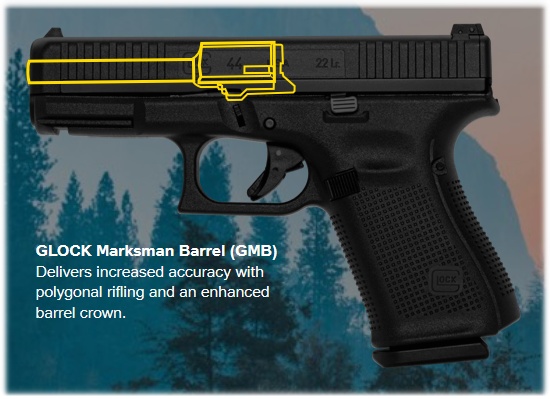
Barrel rifling is 6 grooves with a 1:15.98 inch twist. Of course, polygonal rifling is a type of gun barrel rifling where the traditional sharp-edged lands and grooves are replaced by less-edged “hills and valleys” in a polygonal pattern.
There has been quite a bit of controversy regarding polygonal rifling and the effect of leading. Leading is the buildup of lead in the bore that happens in nearly all firearms firing high velocity lead bullets. This lead buildup must be cleaned out regularly, or the barrel will gradually become constricted resulting in higher than normal discharge pressures. In the extreme case, and especially with larger calibers, increased discharge pressures can result in a catastrophic incident.
No mention of bullet types (lead or jacketed) is mentioned in the instruction manual provided with the pistol. With that said, I would try to limit my use of ammunition to jacketed types.
The rear sight, the usual white-outlined square notch, is adjustable for windage only. An improvement over a fixed rear sight. Sight radius is 6.22 inches.
The slide internals look like any other Glock. The integration of steel and polymer is so well done as to be unnoticeable unless you were looking for specific things, which of course I was. The captured recoil spring and guide should come to no surprise for anyone familiar with Glock pistols.
Toward the rear of the slide, there is a Slide Plate, as Glock calls it.
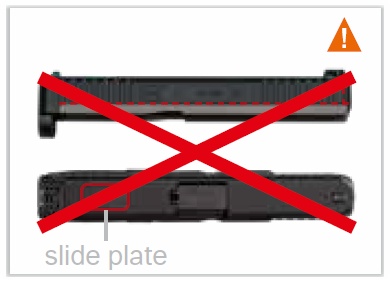
Glock warns that you do not try to remove or manipulate the slide plate or the polymer part of the slide. Any manipulation would void warranty. The reason is that it is part of the steel reinforcement structure for the slide, as shown below.
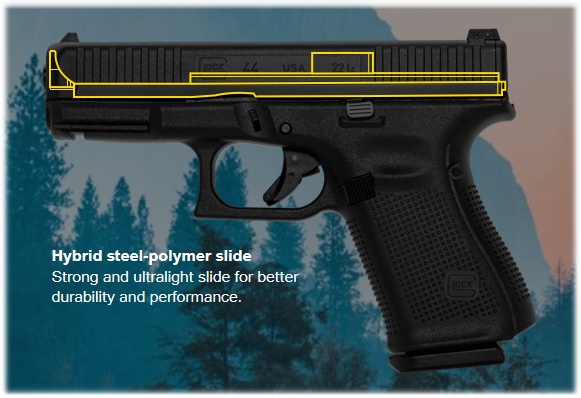
The last point on the slide is the chamber loaded indicator, which is a simple slot at the rear of the chamber that when looked down into will indicate if a cartridge is chambered (or not). Personally, I always regard a firearm as loaded if the action is closed.
Framework
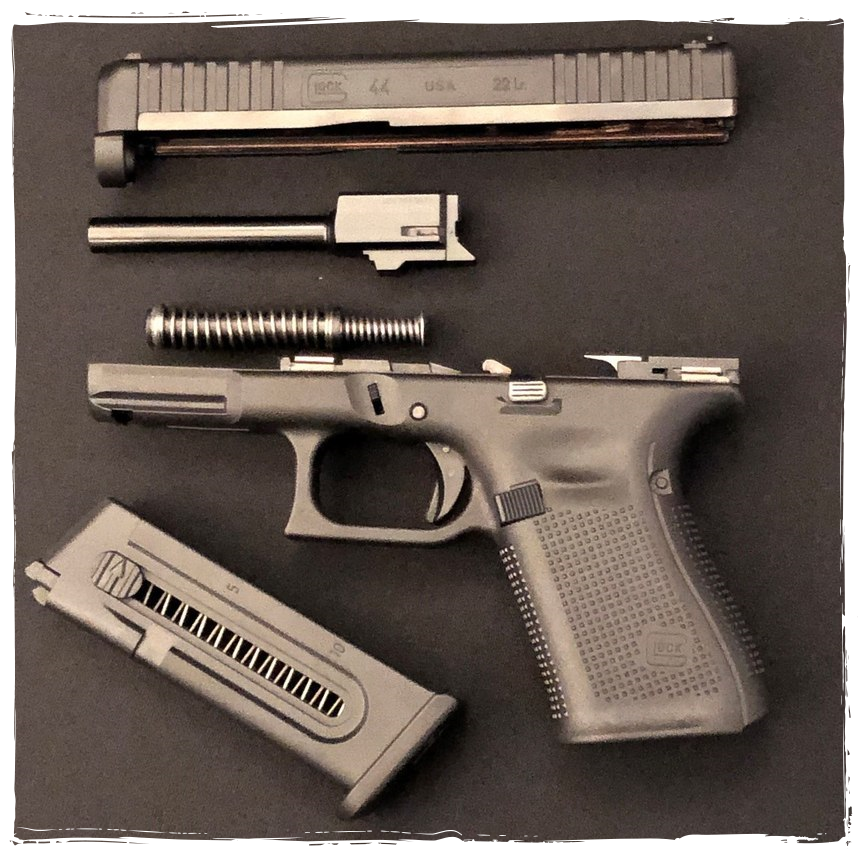
Going back to the frame a bit, I find a lot of similarities with the G44’s frame as with it bigger brother. Since the G44 is a GEN 5 series, the finger grooves are not present as was on the GEN 3 and GEN 4 versions. The grip texture is definitely GEN 5 with its diamond pattern of texturing. This makes for an exceptionally good gripping surface without being obtrusive to the hand.
The bottom of the grip is flared slightly and the magwell is slightly beveled.
The magazine release button can be converted to a right side-only while the Slide Lock is ambidextrous.
With the addition of various grip adapters (without a grip adapter installed, the frame is SF (short frame) sized) the grip can be modified for different sized hands. As I mention, I like beavertails and the large beavertail grip adapter is my choice.
All internals are virtually G19 Glock while the trigger assembly is standard Glock fare with integral trigger safety lever. The trigger pull weight on my scale is 5.8 pounds, which occurs after a short bit of slack. Trigger pull is typical Glock; a slight bit of mush until the striker is released. As usual, it only takes about 1/8-inch of slide rearward travel to cock the pistol. Trigger reset is also typical Glock; brief.
Although the G44 is the same dimension-wise as the Glock G19, do not think that you can interchange them. They are both 7.28 inches in length and are 5.04 inches height. The G44 is slightly less width at 1.26 inches; the G19 is 1.34 inches wide. Swapping slides on G44 and G19 frames was a no go. “Very few of the internal components are the same between the G44 and G19. Most of the internal firing mechanism is unique to the G44 due to the 22 rimfire caliber.” – Source: William Carmichael, Manager of technical Services at Glock.
As with all Glock pistols, an accessory slot is available at the front end for mounting accessories, except for a Slim Jim holder (not yet available for Glock pistols) or bayonet (Author’s Note: There are bayonets available for Glock Glock pistols, but what would you be thinking, Tackleberry? Even John Wick did not use one!).
Last is the fact that the magazine release but can be easily swapped to the right for let handed shooters.
Magazines
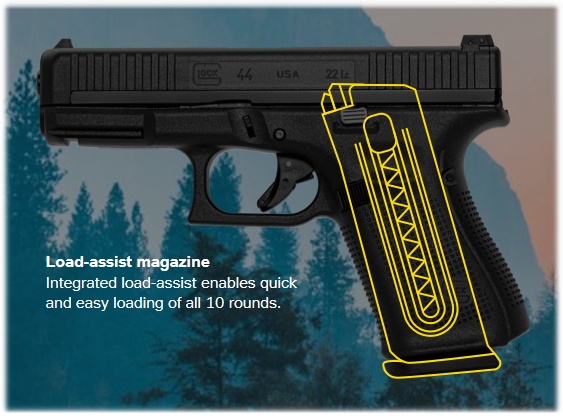
The Glock G44 comes with two 10-round magazine that are somewhat unique. Granted that they hold only ten rounds, but Glock found this capacity to be the most reliable.
The magazine incorporates load assist buttons on each side of the magazine and a means to view the rounds in the magazine. There is also an indicator at the bottom of the magazine that indicates when the pistol is fully loaded.
The magazines are the same physical size as the G19 magazines; therefore, it is theoretically possible to use a magazine extension to provide a pinky rest for those with large hands. More on that in Upgrades.
One feature that a reviewer pointed out is that the magazine is designed so that assists a fresh cartridge into the chamber; a protrusion at the front of the magazine provides better alignment of the cartridge into the chamber.
Glock notes that the side buttons be pressed only far enough to allow loading one cartridge at a time to ensure proper stacking of the cartridges in the magazine.
Glock Safeties
The Glock G44 features the same safety mechanisms as its larger caliber brothers.
- Trigger Safety: The trigger safety is a lever incorporated into the trigger. When the trigger safety is in the forward position it blocks the trigger from moving rearward. The trigger safety and the trigger must be fully pressed at the same time to fire the pistol. If the trigger safety is not pressed, the trigger will not move rearward and allow the pistol to fire. The trigger safety is designed to protect against firing if the pistol is dropped or the trigger is subjected to lateral pressure.
- Firing Pin Safety: The firing pin safety mechanically blocks the firing pin from moving forward in the ready-to-fire condition. As the trigger is pulled rearward the trigger bar pushes the firing pin safety up and frees the firing pin channel. If the user decides not to fire and releases the trigger, the firing pin safety automatically reengages.
- Drop-Safety: The trigger bar rests on the safety ramp within the trigger mechanism housing. The trigger bar engages the rear portion of the firing pin and prevents the firing pin from moving forward. As the trigger is pulled rearward the trigger bar lowers down the safety ramp and allows the release of the firing pin. After firing, the trigger bar moves upward and reengages the firing pin.
Dry Firing
Most are against dry firing a .22 caliber firearm, because of the damage that the firing pin can do to the breech face or to the firing pin itself. There is no mention of dry firing in the instruction manual. Now, it is known that you must pull the trigger to disassemble the Glock pistol, and I felt that the question needed to be asked, so I placed a call to Glock.
The response I received was to limit the amount of dry firing to disassembly only. Otherwise, use a snap cap or other device to prevent damage to the pistol.
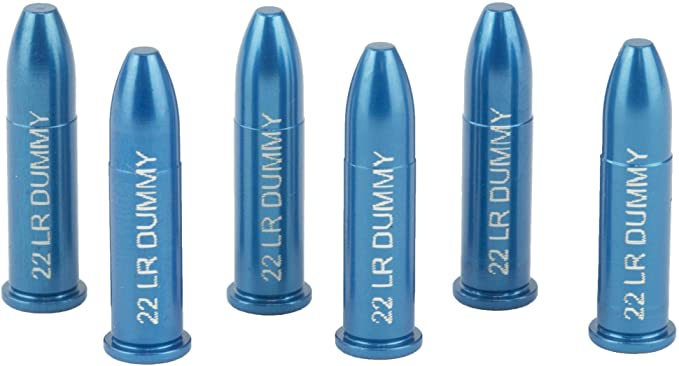
I usually have on hand numerous fired shells and have used them in the past. I also use ribbed plastic anchors, such as those found in many hardware stores and other outlets that fit the .22 barrel. One of those products are the 4-6-8 x 7/8” ribbed plastic anchors from Hillman. Another; albeit more expensive product, is the A-Zoom Precision Dummy Rounds. After each “dummy round” is impacted, it must be rotated – and you can only get so many rotations out of any .22 ‘dummy’ until they become unserviceable. With the A-Zoom product, you get six .22 caliber “dummy” rounds; whereas with the Hillman product, you get 100 per package, and that lessons the costs, overall. Considering that you might get 4 to 5 strikes on each A-Zoom product, that only means 30 strikes at the most; that is $0.038/strike, at the current cost of the product. My practical nerdy side said that I had to experiment with the Hillman product.
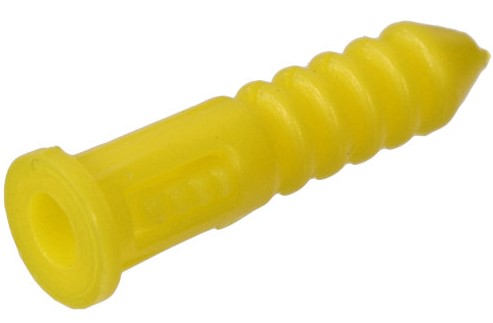
The rim of the Hillman 4-6-8 x 7/8” ribbed plastic anchor is, of course, plastic and would be more forgiving on an extractor than a metal “dummy’ round.
With the action open, I inserted the ‘Hillman Dummy’ into the chamber and slowly let the slide go forward until it was in battery. I then pulled the trigger and commenced to remove the slide from the frame. Once removed, the recoil spring assembly was removed, and the barrel pulled forward. Not surprisingly, the ‘Hillman Dummy” was retained by the extractor. Being plastic, the ‘Hillman Dummy’ was easily removed from the extractor, the barrel was removed in the usual Glock fashion, and the ‘Hillman Dummy’ set aside, as it would be used again after assembling the pistol.
After assembling the pistol, the slide was locked back, the ‘Hillman Dummy’ loaded into the chamber, allow the slide to go forward into battery, and squeeze the trigger. The striker impacts the ‘dummy’ and the ‘dummy’ will remain there until it needs to be removed. No harm, no foul.
Also, my article “Rimfire Protection While Dry-Firing.”
Preflight
My first duty, when bringing the G44 home, was to attach the large beavertail backstrap, which is something that I do to all my Glock that can sport the beavertail grip adapter. GLOCK 44 pistols feature interchangeable backstraps with or without a beaver tail to vary the circumference and the shape of the frame. Without a backstrap attached, the GLOCK 44 pistols have the same frame circumference as the SF models. The medium backstrap adds an additional 0.08 in. / 2mm to the circumference of the frame. The large backstrap adds 0.16 in. / 4mm to the circumference of the frame. The backstraps with a beaver tail come with the same sizes and additionally they are enlarged at the top allowing the shooter’s hand to better stabilize the pistol.
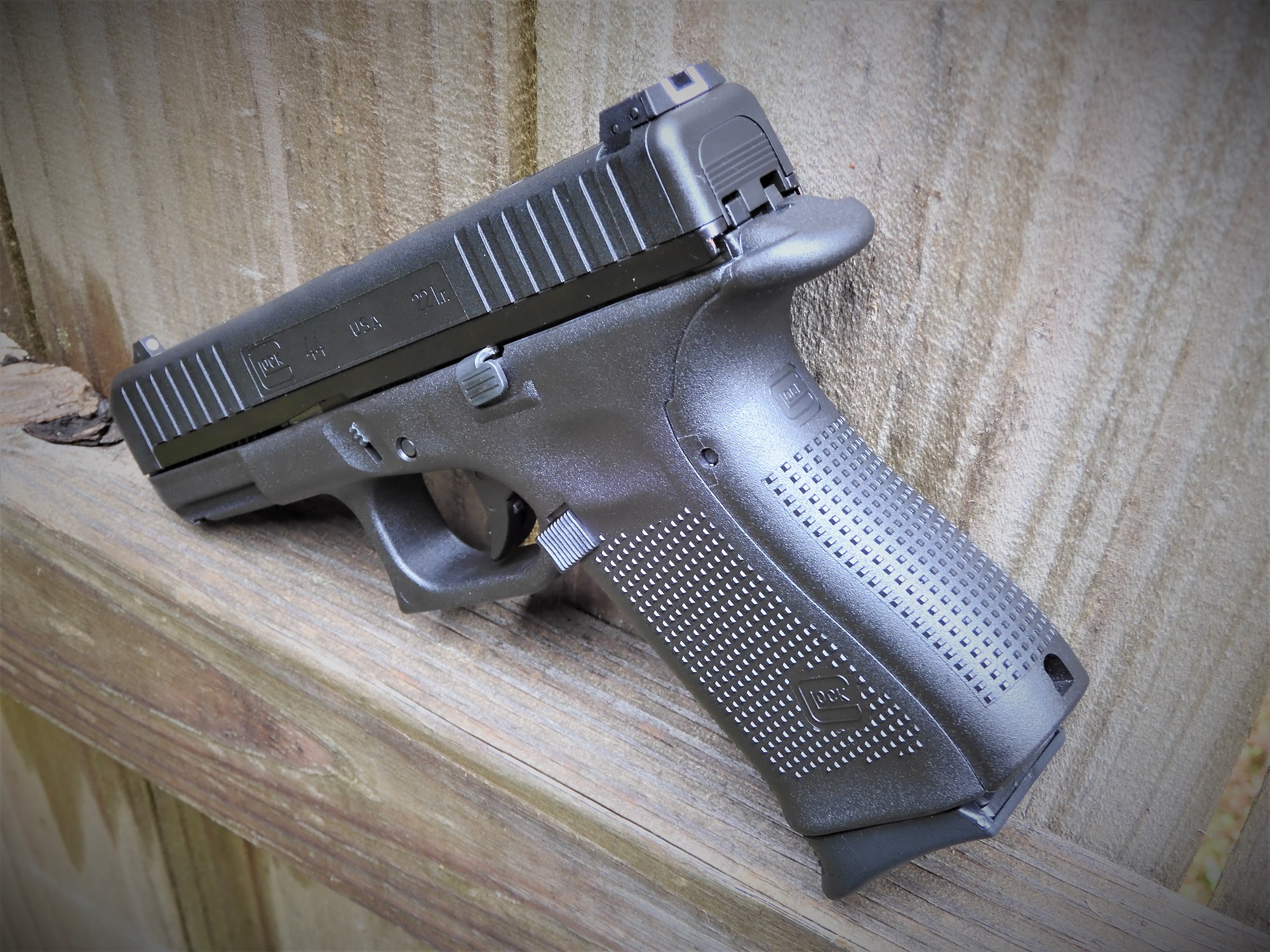
I just like beavertails as much as beavers do, but for a different reason. In the case, the reason was familiarity with the grip. Glock provides a four grip adapter package, which includes two standard adapters, two adapters with beavertail, a carrier, and a replacement pin for the desired grip adapter. A push pin tool is part of the grip adapter package.
Prior to the range session, the pistol was disassembled, cleaned, and lubricated according to the directions provided by Glock in the instruction manual. (Author’s Note: As a Technical Writer by trade, it is important to me that someone takes the time to read what I write. I am sure that the Technical Writers at Glock appreciate that I took the time to read the instruction manual.)
Home, Home on the Range!

I am not one to do magazine dumps, as I do not need to add drama to the shooting event like some who do video reviews. I do not hear Ludwig Van Beethoven’s 5th Symphony in C Minor playing in the background, although I might hum a few bars of “In a Gadda Da Vida” on a few occasions.
Play time is usually spent at seven yards with occasional excursions to greater distances if I feel spunky. Primarily I am checking for functioning of the pistol and relative accuracy from seven to ten yards. This first range day was no different.
I only had ammunition from CCI (Mini-Mag 22 LR HP, 40-grain CPHP @ 1260 fps), Federal Target Grade Performance (40-grain LRN @ 1200 fps) and Remington Thunderbolt (40-grain LRN @ 1258 fps) with me. The Federal and Remington were the first up, as I had hoped to clean any leading out by running the CCI Mini-Mag afterward. The first two magazines were loaded Federal and the G44 was ready to go. I was really interested in how the 4.02-inch Glock polygonal GMB was going to handle this ammunition.
The Federal Target Grade Performance (40-grain LRN @ 1200 fps) functioned perfectly, as did the Remington Thunderbolt (40-grain LRN @ 1258 fps) and CCI (Mini-Mag 22 LR HP, 40-grain CPHP @ 1260 fps).
There were absolutely no FTFs, FTEs, short-stroking, or other malady. Point of impact was nearly point of aim with a slight 6 o’clock hold at ten yards. Felt recoil is next to nothing. The Federal Target Grade Performance (40-grain LRN @ 1200 fps)muzzle blast was near nothing, while the Remington Thunderbolt (40-grain LRN @ 1258 fps) and CCI (Mini-Mag 22 LR HP, 40-grain CPHP @ 1260 fps) made a mini flamethrower out of the Glock G44.
Speaking of the magazines. The magazine has two load assist buttons in the sides of the magazine that are pushed down for inserting fresh rounds. It is best not to run the button all the way to the bottom, but to push down just enough to insert the cartridge. Since rimfire ammunition has a rim, this ensures that the cartridges are properly stacked in the magazine. Push the cartridges all the way to the back of the magazine for best performance results.
A loaded Gen5 G19 weighs 30.16 ounces. A loaded G44 weighs 15.94 ounces. I am used to a full-size 1911 weighing in at around 45.92 ounces at the end of my arms. The weight of the loaded Glock G44 is just two ounces shy of the weight of two 8-round 1911 .45 ACP magazines (17 ounces). Think about that a bit. The Glock G44 weighs less than what I carry for spare ammunition to feed my 1911 EDC.
Shooting the Glock G44 is just a hoot to shoot and made for a very pleasurable range experience.
The Concealment Factor
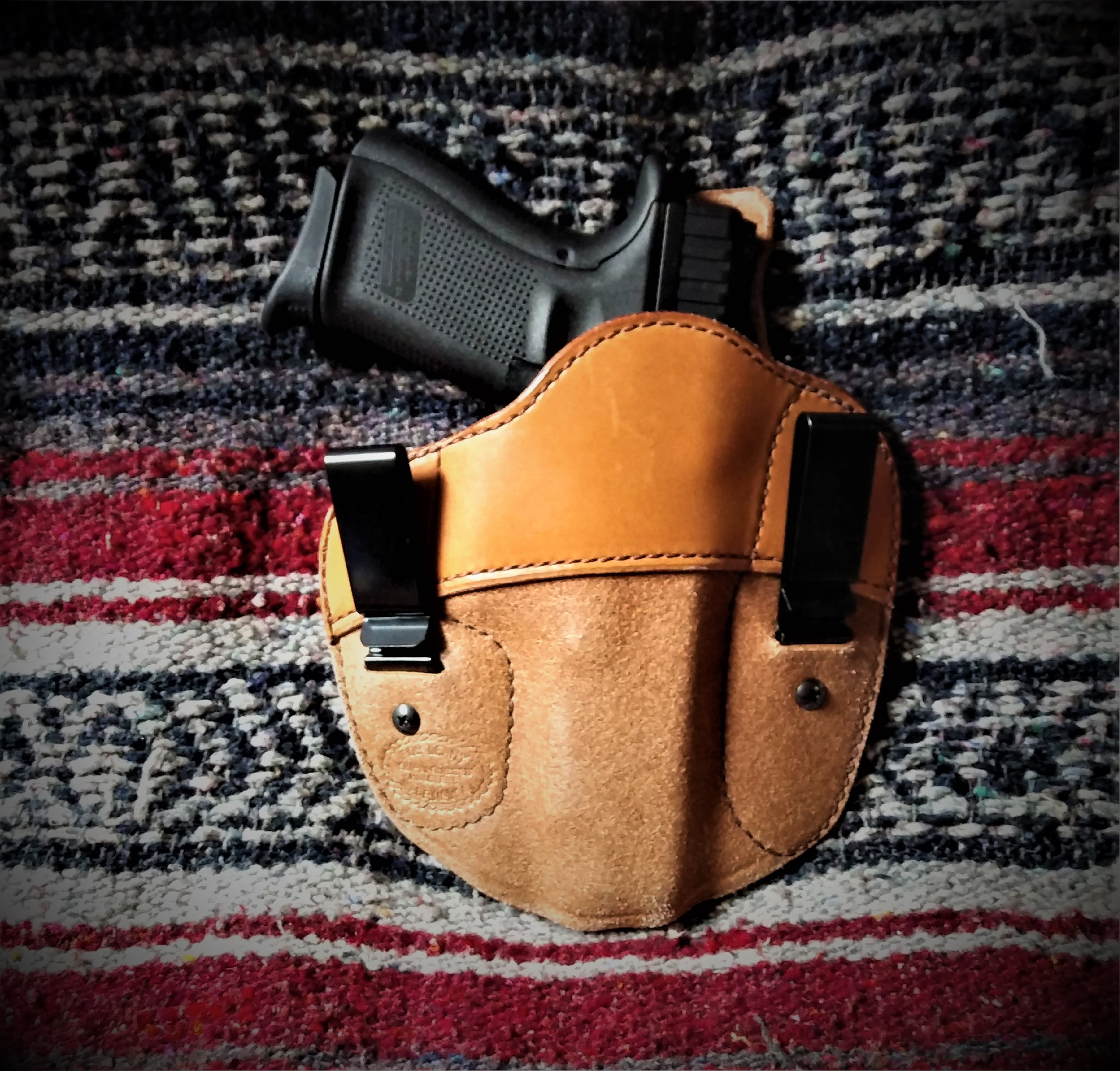
Glock G44 in a “Cumberland” Holster by Simply Rugged Holsters

Glock G44 in a Falco A112 Hawk IWB Holster for Glock G19/G45
Of course, you can conceal the Glock G44! If you have a Glock G19, or a holster for one (IWB or OWB), you are all set. And talk about a light carry! Throw it in a backpack if you want, because if this is not a “kit gun” for the 21st century I do not know what is. I would not carry one in “Grizzly” country, because it would only serve as a toothpick to one of these bruins after they had lunch – with you and your pistol as the main course. But, for little varmints and snakes, it might be an ideal protection device.
Upgrades
Cautions are given, by many, about changing the sights that come with the pistol. Although the front sight is the usual screw-in Glock type sight, the rear sight is the concern. Being that the slide is polymer, damage could occur to the slide if the rear sight was changed. The rear fully adjustable sight of the Glock G44 is perfectly adequate for the pistol, as most sights are. Like the higher caliber pistols, the sights are plastic.
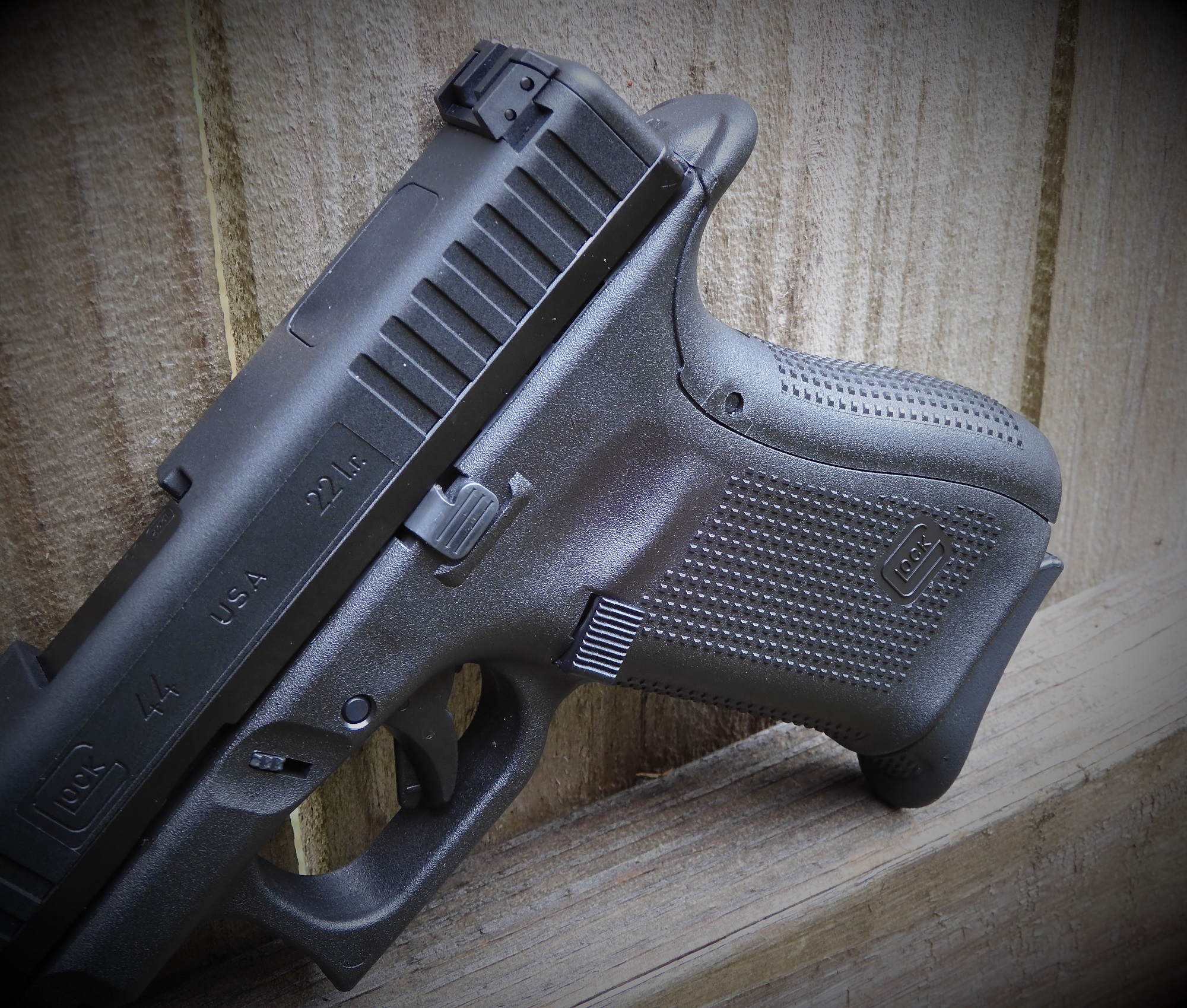
The large beavertail grip adapter was installed as soon as the pistol was signed for. I really like beavertails, beavers, and I really like the beavertails on my Glock pistols that will accept them. The large beavertail grip adapter is perfect for my hand.
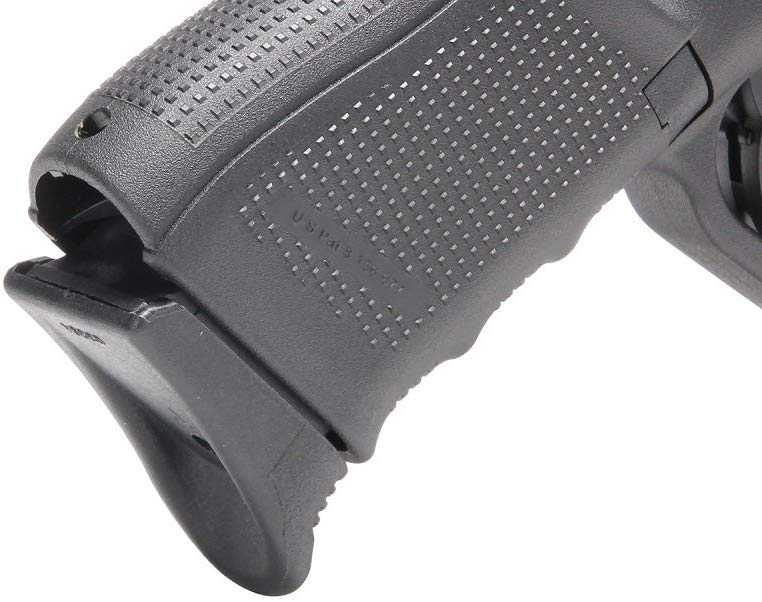
Pachmayr Grip Extender for Glock 17, 18, 19, 22, 23, 24, 25, 31, 32, 34, 35, 37, 38, and now – the 44
The G44 is the same size as the G19, and I have always found the grip length to be lacking in my hand. The magazines for the G44 are the same size as that used in the G19 (and other Glock pistols). I was curious if a magazine extension would work with the G44 magazine. A couple of magazine extensions were ordered to try (they are inexpensive) and with the help of the Glock Magazine Tool, a plastic punch, plastic mallet, and some patience, the bases were changed out not so quickly; the magazine bases are extremely tight and to remove them takes a few four letter words. The Packmayr Grip Extenders; however, fit perfectly. The magazine extender finishes the pistol off, as the texture is the same as the front strap of the G44, and provides a wee bit more space at the bottom of the grip for my hand.
My Final Thoughts
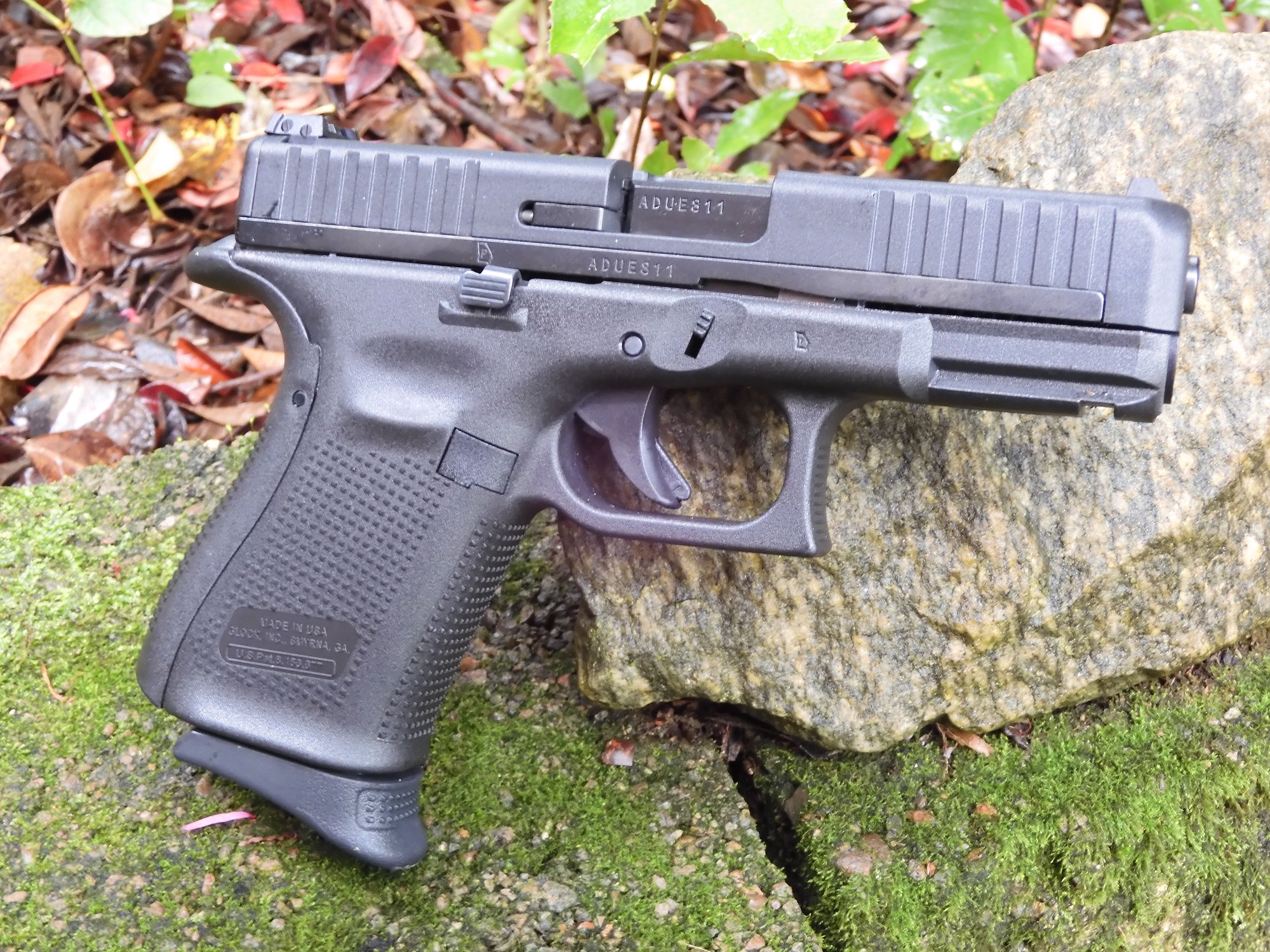

Some would say that a ten round magazine is not enough. Some states dictate that greater than a ten round magazine is too much. You cannot please everybody, but Glock was thinking about sales in those states that prohibit ten round magazines, and they were smart to do so. Also, Glock explained that, if they had their name on a rimfire, they wanted it to be as reliable as possible. This resulted in a 10-shot mag that is crafted where it is almost impossible for a cartridge to not feed correctly. Us Glock customers can adapt and simply carry more magazines, which also help Glock’s bottom line. Everybody wins a prize!
The Glock G44 is just a fun critter to shoot. If you carry a Glock G19 and need some cheap practice, the G44 can feed .22 ammunition all day without breaking the bank. It does like the hotter ammunition and mine did well with CCI Mini-Mag (40-grain CPHP @ 1260 fps). I am sure that CCI Velocitor (40-grain CPHP @ 1435 fps) or CCI Stinger (32-gain CPHP @ 1640) would do well in hollow point ammunition on varmint and small game. For plinking, the CCI Mini-Mag HV (40-grain CPRN @ 1235 fps) may be just the ticket.
The fit of the Glock G44 is awfully familiar in my hand, having shot a few Glock pistols in the past.
One question that might be on people’s mind regard the Glock G44 is reliability. We do have a nylon reinforced polymer frame and a hybrid of polymer and steel in the slide. From what I have read, Glock spent close to three years testing and developing the G44, which is why models like the G45, G46, G47, and G48 passed it up in reaching the market; the G44 was still in R&D. During that time, they used no less than 141 different rimfire loads in testing, expending over 1.2 million rounds in the process. Federal, which supported the effort, used everything in test guns from 42-grain subsonic to CCI Stingers with no problem.
Of course, magazine capacity is not as high as, say the Taurus TX22 (16+1) or Kel-Tec CP33 (33+1), but neither of those are Glocks, which are in a league of their own. Conversion kits for the Glock G19 are available and some reliability issues have surfaced using these conversion kits. What you get with the G44 is a proven and tested pistol already chambered in .22 caliber. Given the price difference between some of these kits and the G44, a pistol specifically designed around the .22 LR cartridge, the G44 is the better deal.
While I did not have any Glock purchases authorized by higher command, The G44 has completed the spectrum of Glock pistols that I wanted, and maybe I just needed this one as well. Besides, there is always room for another 22.
A threaded barrel is already separately offered for those who would like to run a can on their G44. That could be another article in the making.
As a last word, the Glock G44 is U.S. A. made.
Resources
Here are a few of the many videos regarding the Glock G44:
- Glock 44 .22lr “Perfectly Imperfect”: https://www.youtube.com/watch?v=ZkxtFN6QJPk
- Glock G44 22 LR Pistol Full Review Revised: https://www.youtube.com/watch?v=u0gEagPOfXU
- First Look: The Glock G44 Rimfire: https://www.youtube.com/watch?v=TbFMJw9JnlY
- GLOCK G44 22LR REVIEW | How Reliable is a Glock 22lr?: https://www.youtube.com/watch?v=BhZiVeVER2Q
- Have we changed our minds about the .22 cal. Glock 44? | GearScout Down Lowe: https://www.youtube.com/watch?v=WD9q9TrrSBQ
- Glock 44 Unboxing & 1st Shots: https://www.youtube.com/watch?v=7mQ1ZXTAdqM
- Glock 44 Initial Review (01-22-2020): https://www.youtube.com/watch?v=pgLXk2AGXCE
- GLOCK 44 22 AFTER 1600 ROUNDS: https://www.youtube.com/watch?v=ODuNacWoMrU
- GLOCK 44 22LR – IS IT WORTH THE MONEY? (22Plinskter): https://www.youtube.com/watch?v=Ginch2koH8E
![]()

